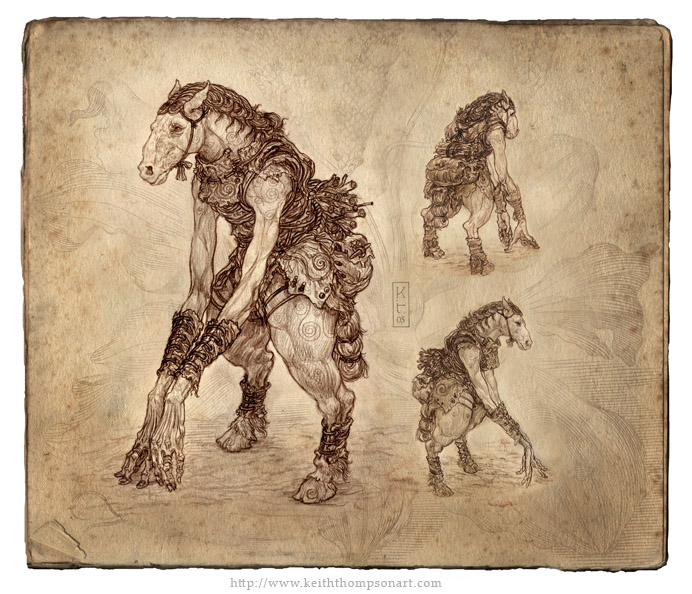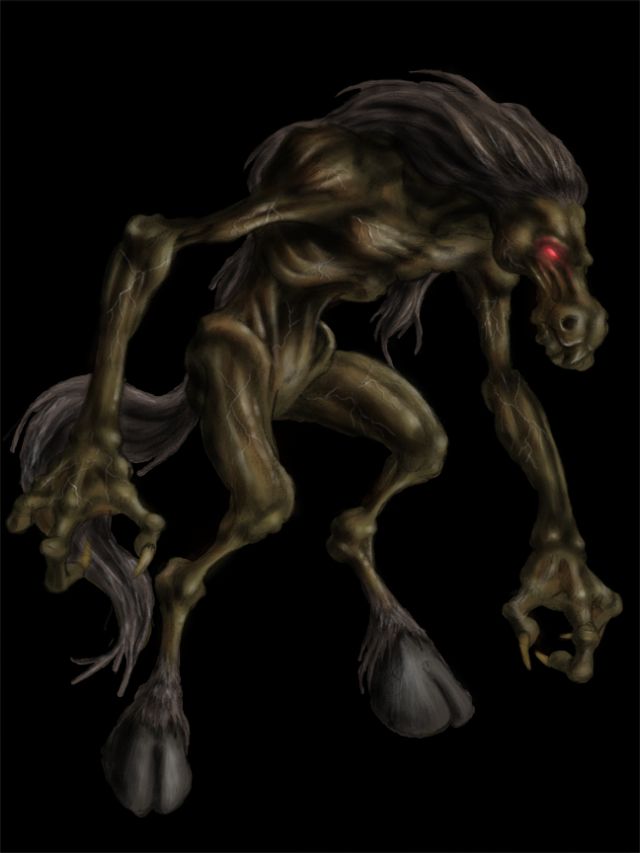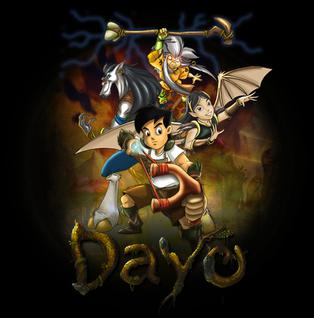The tikbalang myth originated during Spanish colonization. Conquistadors introduced horses to the Philippines and then spread rumors to make the native people afraid of the night. This might help explain why there so much conflicting information about tikbalang. They only had to make enough sense to scare people.
A tikbalang is half man, half horse monster. It is tall and boney with disproportionately long limbs. It is often described as having legs so long that, when it squats, its knees are above its head. I've only found one illustration that give a tikbalang legs that long and it wasn't very good. Instead, tikbalang are usually drawn with long arms. Most sources say tikbalang live in forests and mountains but some say they live in swamps, under bridges, or in trees. There is agreement, however, that tikbalang smoke cigars.
Tikbalang spend their days messing with travelers. How serious they are depends on which myth you prefer. There are accounts of them being mischievous and sending people in confused, endless circles. Other myths make them angry and aggressive, going so far as to kill the unfortunate traveler. It is widely believed that you can counteract the tikbalang's trouble-making by wearing your shirt inside out. No one has been able to explain to me how this works. You can also politely ask permission to pass by a tikbalang, which makes far more sense to me.
The more research I do on tikbalang, the more out-of-place snippets I find. Tikbalang can turn invisible. They can turn into humans. They can mimic voices. They are benevolent guardians of elemental kingdoms. They are demons. They only bath on full moons. They are beautiful women who grew very old. They are aborted fetuses sent back to Earth from limbo. They are actually half-bird, half-man. They ask their prey a riddle and those who answer right get a pot of gold. Personally, I don’t like most of these traits. They are better suited to other creatures. However, if I wanted to use any of these abilities, they are available.
Most sources agree that a tikbalang can be tamed. They just don’t agree on how. The story I have heard most often is that a tikbalang has a mane of sharp spikes and, if you get one of the three thickest ones, you can use it to make the tikbalang your servant. However, you must subdue it first by riding it until it is exhausted and admits defeat. Another version of the story says you must pluck three golden hairs from its mane to tame it.
There is a Filipino movie called Dayo: Sa Mundo ng Elementalia which features a tikbalang among other mythological Filipino creatures. I haven’t been able to find a copy but, hopefully, I will before next semester.
So far, I haven’t been able to draw my tikbalang successfully. Part of the mythology is that they have strange proportions, which isn’t helping. I do have a good grip on his personality but I’ll save that discussion for this week’s class. I am sure of one thing, though. There is a saying about rain on days with clear skies. May kinakasal na tikbalang. A tikbalang is getting married. Since there is a saying about their weddings, I want my tikbalang to wear a wedding ring.






These guys are cool. I like that you're giving him a wedding ring, that way he can be strange, but also familiar.
ReplyDeleteI think the first drawing will probably be the easiest to pull the anatomy from. May want to makes the arms a bit shorter than they're shown, so that the movement isn't too ungainly. Since he has hooves instead of feet, he'll walk like he's on his tiptoes.
Filipino myths are crazy and very much unclear I agree, but you could try to merge some of them together, like the hair thing; get all three golden strands and bam! one inverted centaur servant at your service.
ReplyDeleteand for the mix-match info, well I could suggest that there different kinds of tikbalang that lives in different regions. in your story, your main tikbalang could be mischievous and lives in trees (because I feel rosalinda's story is set in province like Ilo-ilo or Bacolod)
other than that, this is awesome :D